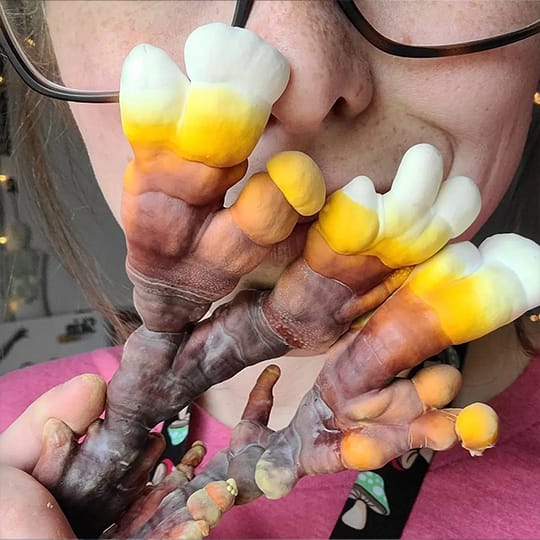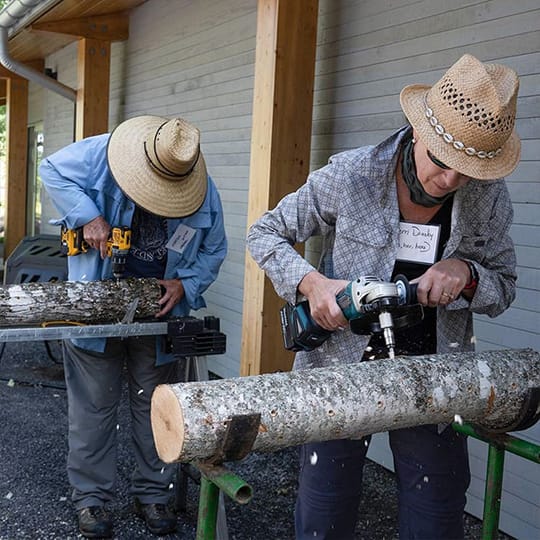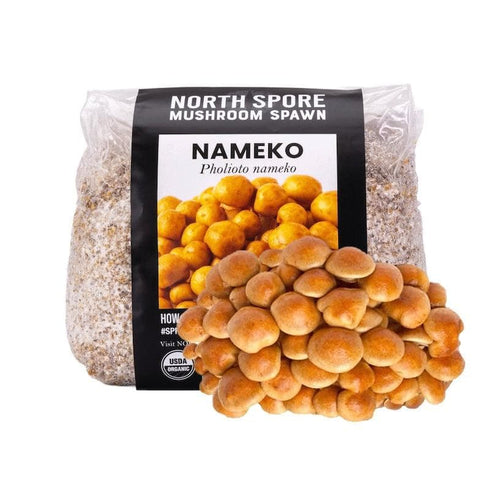

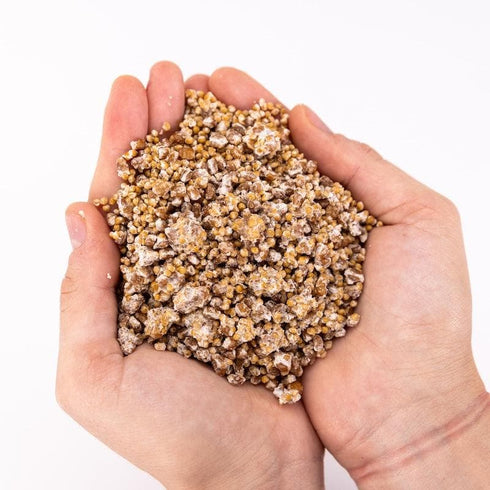
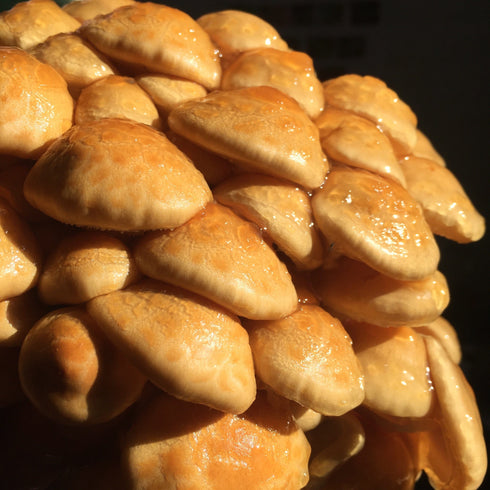
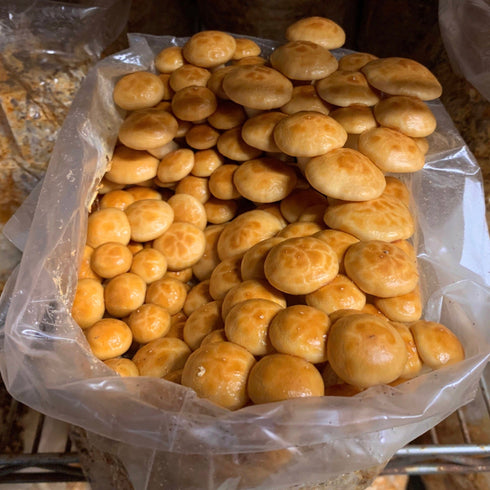
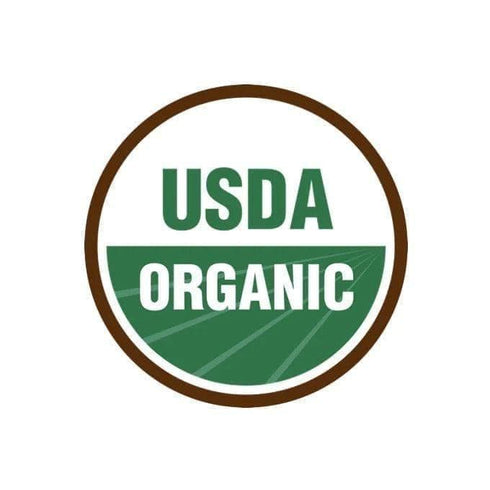








| Skill level | Advanced |
| Grow location | Indoors |
| Spawn shelf life | 4 months (refrigerated) |
| Certifications | USDA certified organic |
| Bag weight | 6 lbs |
| Fruiting temps | 45-65°F |
Our USDA-certified organic nameko (Pholiota nameko) grain spawn features a popular strain that's widely cultivated in Japan. As these mushrooms grow, they are covered in a layer of natural gelatin which gives them a unique, almost shiny appearance. When cooked, nameko has an earthy flavor with subtle fruit-like hints, and an aroma reminiscent of cashews and butterscotch.
Because they need cooler temperatures and constant humidity when fruiting, they require patience and precision. They are not ideal for beginners but can be quite rewarding for experienced growers.
"5 of the Best Nameko Mushroom Recipes"
Recommended use:
- Nameko grain spawn can be used for indoor production using sawdust-based sterilized substrate.
- Do not use grain spawn for log inoculation.
- This is not a mushroom grow kit. Nameko grain spawn must be combined with a substrate in order to fruit.
Upon receiving your spawn:
Remove it from the shipping box as soon as possible. Then, unfold the top of the bag, making room for air space. It's also important to check and confirm that the filter patch is not obstructed. This will help the organism breathe and continue to thrive!
Scroll down for specifications, growing, and storage guides.
-
- Weight: Approximately 6 lbs
- Hydration: Average of 47%
- Bags: Gusseted 2.2 mil polypropylene
- Filter: High efficiency .2 micron
- Inoculation Rates: 6 lb. bag of grain will inoculate between 120-165 lb. sterilized sawdust
- Sterilization method: Commercial grade autoclave sterilized
-
Temperature 45-65°F | 7-18°C Humidity (Phase 1: Primordia) 98-100% Humidity (Phase 2: Fruitbody) 88-95% CO2 Sensitivity (Phase 1: Primordia) 500-1,000 ppm CO2 Sensitivity (Phase 2: Fruitbody) <1,000 ppm - Primordia - The earliest recognizable stage of fruitbody development. Also known as “baby mushrooms” or “mushroom pins.”
- Fruitbody - A fully grown mushroom, the reproductive structure of the organism in which the spores are produced.
- CO2 sensitivity - When CO2 levels are too high, yields will decrease, stems will become long and stringy, caps will be small, and/or growth will halt.
-
Nameko mushroom grain spawn can be mixed into sterilized hardwood sawdust to create nameko substrate blocks.
Note: Grain spawn must be mixed with bulk substrate before you can fruit it. If you are new to growing mushrooms, we recommend purchasing a book on mushroom cultivation.
Recommended reading:
'Growing Gourmet and Medicinal Mushrooms' by Paul Stamets
'Organic Mushroom Farming and Mycoremediation' by Tradd Cotter
-
If you don't plan to use immediately, you can refrigerate your spawn for up to 4 months.
-
Nameko is a lesser known culinary mushroom in the Americas, but it is used widely in East Asia. It has a gelatinous cap that can thicken soups and sauces and has an aroma that walks the line of being both fruity and earthy. Nameko mushrooms go well with dark green vegetables, red meats, and shallots, and are used traditionally in Japanese miso soups.
-
Our grain spawn is USDA certified organic and made using organic cultures from our own culture bank. It contains a blend of locally sourced, organic, and non-GMO grains and supplements from farms in New England and North America.
-
If you’re going to consume home-grown mushrooms, make sure to cook your fresh mushrooms thoroughly with heat. If it is your first time eating this species, it is best to start with a small amount to check for allergies, even if cooked.
You may also like
Making the world of mushrooms accessible to all
North Spore was launched in 2014 by a mycologist, an organic farmer, and a photojournalist -- three college friends brought together through their shared love of the mycological world.
What began as a simple love for mushroom foraging and cultivation quickly developed into an obsession with all things fungi. From there, an urban mushroom farm was born, as was the desire to spread the spore to the masses.
- Reviews
- Questions
Thank you for submitting a review!
Your input is very much appreciated. Share it with your friends so they can enjoy it too!
Enjoyed growing these
First time with namekos. Definitely trickier than other mushrooms, but I'm very glad I tried it. Very happy with the results. Will buy again.






